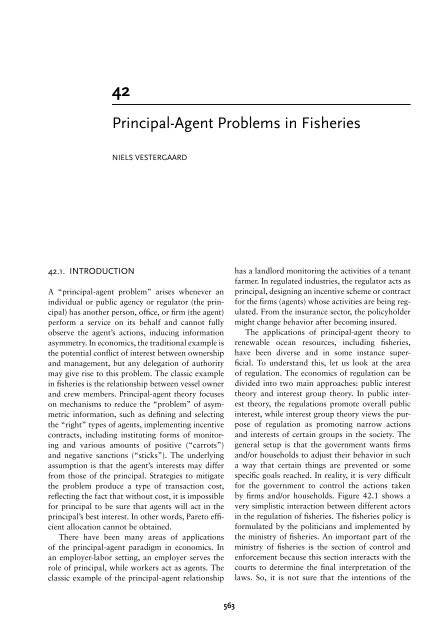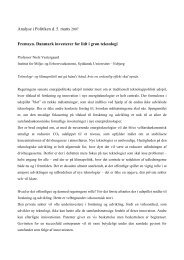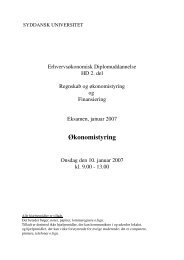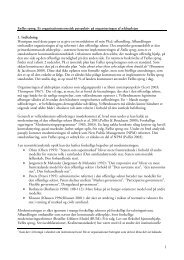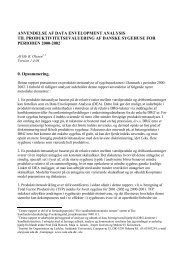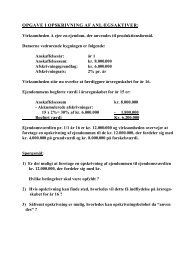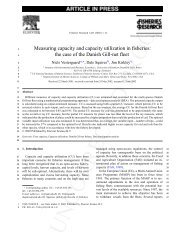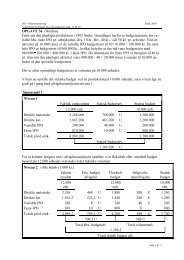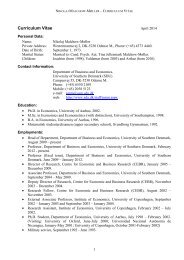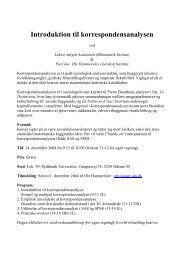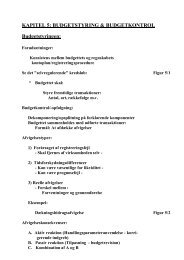Principal-Agent Problems in Fisheries - lah@sam.sdu.dk
Principal-Agent Problems in Fisheries - lah@sam.sdu.dk
Principal-Agent Problems in Fisheries - lah@sam.sdu.dk
You also want an ePaper? Increase the reach of your titles
YUMPU automatically turns print PDFs into web optimized ePapers that Google loves.
42<strong>Pr<strong>in</strong>cipal</strong>-<strong>Agent</strong> <strong>Problems</strong> <strong>in</strong> <strong>Fisheries</strong>NIELS VESTERGAARD42.1. INTRODUCTIONA “pr<strong>in</strong>cipal-agent problem” arises whenever an<strong>in</strong>dividual or public agency or regulator (the pr<strong>in</strong>cipal)has another person, office, or firm (the agent)perform a service on its behalf and cannot fullyobserve the agent’s actions, <strong>in</strong>duc<strong>in</strong>g <strong>in</strong>formationasymmetry. In economics, the traditional example isthe potential conflict of <strong>in</strong>terest between ownershipand management, but any delegation of authoritymay give rise to this problem. The classic example<strong>in</strong> fisheries is the relationship between vessel ownerand crew members. <strong>Pr<strong>in</strong>cipal</strong>-agent theory focuseson mechanisms to reduce the “problem” of asymmetric<strong>in</strong>formation, such as def<strong>in</strong><strong>in</strong>g and select<strong>in</strong>gthe “right” types of agents, implement<strong>in</strong>g <strong>in</strong>centivecontracts, <strong>in</strong>clud<strong>in</strong>g <strong>in</strong>stitut<strong>in</strong>g forms of monitor<strong>in</strong>gand various amounts of positive (“carrots”)and negative sanctions (“sticks”). The underly<strong>in</strong>gassumption is that the agent’s <strong>in</strong>terests may differfrom those of the pr<strong>in</strong>cipal. Strategies to mitigatethe problem produce a type of transaction cost,reflect<strong>in</strong>g the fact that without cost, it is impossiblefor pr<strong>in</strong>cipal to be sure that agents will act <strong>in</strong> thepr<strong>in</strong>cipal’s best <strong>in</strong>terest. In other words, Pareto efficientallocation cannot be obta<strong>in</strong>ed.There have been many areas of applicationsof the pr<strong>in</strong>cipal-agent paradigm <strong>in</strong> economics. Inan employer-labor sett<strong>in</strong>g, an employer serves therole of pr<strong>in</strong>cipal, while workers act as agents. Theclassic example of the pr<strong>in</strong>cipal-agent relationshiphas a landlord monitor<strong>in</strong>g the activities of a tenantfarmer. In regulated <strong>in</strong>dustries, the regulator acts aspr<strong>in</strong>cipal, design<strong>in</strong>g an <strong>in</strong>centive scheme or contractfor the firms (agents) whose activities are be<strong>in</strong>g regulated.From the <strong>in</strong>surance sector, the policyholdermight change behavior after becom<strong>in</strong>g <strong>in</strong>sured.The applications of pr<strong>in</strong>cipal-agent theory torenewable ocean resources, <strong>in</strong>clud<strong>in</strong>g fisheries,have been diverse and <strong>in</strong> some <strong>in</strong>stance superficial.To understand this, let us look at the areaof regulation. The economics of regulation can bedivided <strong>in</strong>to two ma<strong>in</strong> approaches: public <strong>in</strong>teresttheory and <strong>in</strong>terest group theory. In public <strong>in</strong>teresttheory, the regulations promote overall public<strong>in</strong>terest, while <strong>in</strong>terest group theory views the purposeof regulation as promot<strong>in</strong>g narrow actionsand <strong>in</strong>terests of certa<strong>in</strong> groups <strong>in</strong> the society. Thegeneral setup is that the government wants firmsand/or households to adjust their behavior <strong>in</strong> sucha way that certa<strong>in</strong> th<strong>in</strong>gs are prevented or somespecific goals reached. In reality, it is very difficultfor the government to control the actions takenby firms and/or households. Figure 42.1 shows avery simplistic <strong>in</strong>teraction between different actors<strong>in</strong> the regulation of fisheries. The fisheries policy isformulated by the politicians and implemented bythe m<strong>in</strong>istry of fisheries. An important part of them<strong>in</strong>istry of fisheries is the section of control andenforcement because this section <strong>in</strong>teracts with thecourts to determ<strong>in</strong>e the f<strong>in</strong>al <strong>in</strong>terpretation of thelaws. So, it is not sure that the <strong>in</strong>tentions of the563
564Policy Instruments and Perspectivespoliticians are put <strong>in</strong>to practice. The fish<strong>in</strong>g firmsmay consist of the owners, managers (e.g., the skipper),and a range of employees or crew members.The skipper and the crew members are actuallydo<strong>in</strong>g the fish<strong>in</strong>g, not necessarily the owner. Eventhough the figure is miss<strong>in</strong>g the consumer side, it issufficient to show that the l<strong>in</strong>ks between the politiciansat the one hand and the skipper and crew onthe other hand are imperfect. When the government(pr<strong>in</strong>cipal) cannot precisely control the fishermen(agent) has been termed a pr<strong>in</strong>cipal-agent problem.In the political economy literature, the situation<strong>in</strong> which a state agency (agent) pursues its own<strong>in</strong>terest, which may differ from the <strong>in</strong>terest of thegovernment (pr<strong>in</strong>cipal), is called a pr<strong>in</strong>cipal-agentproblem. Here the problem may be connected tothe rent-seek<strong>in</strong>g issue that arises when agents fromthe regulated <strong>in</strong>dustry try to <strong>in</strong>fluence the regulation<strong>in</strong> their favor (e.g., lobby<strong>in</strong>g us<strong>in</strong>g resourcesto acquire subsidies). Both of these problems arisewith conflict<strong>in</strong>g objectives and strategies betweenagents and the regulators, and they both contributeto government failure (for an overview, seeEdwards 1994).The problem with this approach to regulation isthat although it might emphasize that actors whoare go<strong>in</strong>g to be regulated by the government cannotbe expected to adjust passively to the regulation, itdoes not explicitly state the asymmetric <strong>in</strong>formationproblem, which is a market failure (see Hanleyet al. 1997). In fact, it is the op<strong>in</strong>ion of the authorthat studies of the <strong>in</strong>terplay between a pr<strong>in</strong>cipal andan agent or the regulator and the regulated shouldhave some k<strong>in</strong>d of asymmetric <strong>in</strong>formation problemattached before it can be called a pr<strong>in</strong>cipal-agentstudy. Otherwise, it is “just” a study where the regulatortakes the reaction by the agent <strong>in</strong>to accountPoliticiansM<strong>in</strong>istry/regulator(control and enforcement)CourtLobby<strong>in</strong>gOwnerManager/skipperCrewFIGURE 42.1 Interactions among the politicians, thegovernment, and the fish<strong>in</strong>g firmswhen the regulation is designed, which every soundregulation model has to do. In fact, several of theapplications of the pr<strong>in</strong>cipal-agent model <strong>in</strong> fisheriesdo not <strong>in</strong>clude the <strong>in</strong>formation problem, and hencecannot be called pr<strong>in</strong>cipal-agent analyses (see section42.3). 1 Jensen (2008) provides a recent reviewon uncerta<strong>in</strong>ty and asymmetric <strong>in</strong>formation <strong>in</strong> thefisheries regulation economics literature, where thepurpose is to dist<strong>in</strong>guish when uncerta<strong>in</strong>ty can be<strong>in</strong>terpreted as asymmetric <strong>in</strong>formation.This chapter presents pr<strong>in</strong>cipal-agent theory,with an emphasis on identify<strong>in</strong>g the <strong>in</strong>stances whenit is suitable to apply the pr<strong>in</strong>cipal-agent approachand what are the ga<strong>in</strong>s <strong>in</strong> knowledge. It then surveysdifferent applications of the pr<strong>in</strong>cipal-agentapproach <strong>in</strong> fisheries.42.2. PRINCIPAL-AGENTTHEORYKwerel (1977) wrote:In a world of perfect <strong>in</strong>formation, optimal regulationof an isolated economic variable would berelatively straightforward. Unfortunately, we donot live <strong>in</strong> such a world. Regulatory authoritiestypically f<strong>in</strong>d that the <strong>in</strong>formation which theyneed dur<strong>in</strong>g the plann<strong>in</strong>g phase is known only bythose who are to be regulated. In this situationa serious <strong>in</strong>centive problem may arise. Unless asystem can be designed which makes the objectivesof the <strong>in</strong>dividual agents co<strong>in</strong>cide with theregulator’s objectives, self-<strong>in</strong>terested agents willsystematically deceive the regulatory authoritywhen asked to reveal their <strong>in</strong>formation.The economics of <strong>in</strong>formation and <strong>in</strong>centives hasdeveloped greatly <strong>in</strong> recent years. In the economictheory of contracts, agents are characterized byprivate <strong>in</strong>formation that determ<strong>in</strong>es their ultimateactions. The two key features of pr<strong>in</strong>cipal-agentproblems are that (1) the pr<strong>in</strong>cipals know less thanthe agents about someth<strong>in</strong>g important, and that (2)their <strong>in</strong>terests conflict <strong>in</strong> some way (see Sapp<strong>in</strong>gton1991; two more recent <strong>in</strong>troductions are Macho-Stadler and Pérez-Castillo 2001; Laffont and Martimort2002).There seem to be two sources of asymmetric<strong>in</strong>formation problems:• <strong>Problems</strong> where agents can do some costlyaction to improve outcomes for the pr<strong>in</strong>cipal,
<strong>Pr<strong>in</strong>cipal</strong>-<strong>Agent</strong> <strong>Problems</strong> <strong>in</strong> <strong>Fisheries</strong> 565but the pr<strong>in</strong>cipal cannot observe the action.These are known as moral hazard or hiddenaction problems. For example, this can<strong>in</strong>volve effort <strong>in</strong> a production process or protectionaga<strong>in</strong>st risk.• <strong>Problems</strong> where there are different types ofagents, and pr<strong>in</strong>cipals cannot dist<strong>in</strong>guishbetween them. 2 These are known as adverseselection or hidden <strong>in</strong>formation problemswhen the types are fixed and the question iswhich agents will participate. For example,this can <strong>in</strong>clude efficiency <strong>in</strong> terms of cost orwill<strong>in</strong>gness to pay for a given good.While the type of the agent is unknown to the pr<strong>in</strong>cipal,the latter nevertheless is assumed to haveprior <strong>in</strong>formation before the contract is negotiated,<strong>in</strong> terms of the statistical distribution of the typeand other relevant characteristics of the agent. Thechallenge for the pr<strong>in</strong>cipal is to set up a contractscheme enforc<strong>in</strong>g truthful revelation of the private<strong>in</strong>formation, thus allow<strong>in</strong>g a second-best optimumto be atta<strong>in</strong>ed for the economic variable of <strong>in</strong>terest(production level, environmental externality, etc.).This is called the revelation pr<strong>in</strong>ciple. 3 In practice,contracts are largely used <strong>in</strong> doma<strong>in</strong>s such as <strong>in</strong>surance,public regulation, <strong>in</strong>dustrial relationships,agricultural production, and employment procedures.This suggests that asymmetric <strong>in</strong>formationcan be present <strong>in</strong> many situations and must betaken <strong>in</strong>to account <strong>in</strong> almost every regulatory andempirical analysis.The tim<strong>in</strong>g of the <strong>in</strong>teractions between pr<strong>in</strong>cipaland agent is shown <strong>in</strong> figure 42.2. A contractis offered to the agent, which the agent can eitheraccept or refuse. If the agent refuses, the <strong>in</strong>teractionstops. If the agent accepts, the contract is executed.The sequence of decisions is important because ateach po<strong>in</strong>t <strong>in</strong> time the agent and pr<strong>in</strong>cipal have tomake decisions based on the available <strong>in</strong>formation.Therefore, a correct classification of the asymmetric<strong>in</strong>formation situation is important (see Macho-Stadler and Pérez-Castillo 2001).The advantage of the pr<strong>in</strong>cipal-agent approachis that the <strong>in</strong>centives at stake are highlighted. Thefocus is on the regulation problem, where the issueis to align the <strong>in</strong>centives of the private firms so thesocial objectives can be met. Put <strong>in</strong> another way, <strong>in</strong>fisheries, if the reactions of the fishermen are nottaken <strong>in</strong>to account when formulat<strong>in</strong>g the fisherypolicy of keep<strong>in</strong>g, for example, the stock size with<strong>in</strong>optimal size (e.g., assume that the fishermen passivelyadjust to quota sett<strong>in</strong>gs), then the policy canlead to suboptimal and unexpected results. Anotheradvantage of the pr<strong>in</strong>cipal-agent approach is thatthe <strong>in</strong>formation problems are explicitly taken <strong>in</strong>toaccount when sett<strong>in</strong>g up the <strong>in</strong>centive scheme. Thepr<strong>in</strong>cipal submits to the agents a menu of contractsthat are conditioned on what both the pr<strong>in</strong>cipaland the agent can observe and on what can be verified<strong>in</strong> the legal system. In other words, asymmetric<strong>in</strong>formation is <strong>in</strong>cluded explicitly, because thecontract cannot be conditioned on what only theagents know.Adverse Selection<strong>Agent</strong>knowshis type<strong>Pr<strong>in</strong>cipal</strong>offers acontract<strong>Agent</strong>acceptorrefusesThecontractisexecutedMoral Hazard<strong>Pr<strong>in</strong>cipal</strong>offers acontract<strong>Agent</strong>accept orrefuses<strong>Agent</strong>exerts aneffort ornotTheoutcomeis realizedand thecontract isexecutedFIGURE 42.2 Tim<strong>in</strong>g of contract offers and <strong>in</strong>teractions between thepr<strong>in</strong>cipal and the agent
566Policy Instruments and Perspectives42.3. APPLICATIONS OFPRINCIPAL-AGENT THEORY TOFISHERIESThe pr<strong>in</strong>cipal-agent model can be applied to differentareas <strong>in</strong> fisheries such as share contracts, <strong>in</strong>ternationalfish<strong>in</strong>g agreements, illegal land<strong>in</strong>gs anddiscards, safety, and <strong>in</strong>vasive species.42.3.1. Share ContractsShare contracts are used as the ma<strong>in</strong> remunerationsystem <strong>in</strong> commercial fisheries all over the world.The fishermen or crew are paid not a fixed wage perhour but as a share of the revenue obta<strong>in</strong>ed by thecatch of the vessel. These systems vary across countries,vessel types, and fisheries. In some systems,some of the common variable costs are deductedbefore the revenue is divided by the crew and thevessel owner, and <strong>in</strong> some systems the crew receivessome m<strong>in</strong>imum wage comb<strong>in</strong>ed with a share of therevenue obta<strong>in</strong>ed.Sut<strong>in</strong>en (1979) analyzed the social desirabilityof the share system and concluded that “the sharesystem of remuneration is viewed as mak<strong>in</strong>g a significantpositive contribution to the developmentof a fish<strong>in</strong>g <strong>in</strong>dustry.” This result is driven by riskaversevessel owners and competitive labor markets.Under the share system, the vessel owners canspread some of the risk to the crew, reduc<strong>in</strong>g therisk cost. Sut<strong>in</strong>en does not explicitly mention themoral hazard problem due to private <strong>in</strong>formationabout the effort level of the crew, and he does notcall the approach a pr<strong>in</strong>cipal-agent analysis. However,he writes that the share system “provides awork <strong>in</strong>centive that makes it less costly to extractthe desired level of labour services from the crew.”The analysis is done <strong>in</strong> a static framework.In two studies, Hämälä<strong>in</strong>en et al. (1986,1990)analyzes the issue of share-fish<strong>in</strong>g <strong>in</strong> a pr<strong>in</strong>cipalagentand a dynamic fishery model. They use theterm “Stackelberg game” as <strong>in</strong>terchangeable withthe pr<strong>in</strong>cipal-agent model because the pr<strong>in</strong>cipal(called leader <strong>in</strong> the Stackelberg game) def<strong>in</strong>es thegame and takes <strong>in</strong>to account the reaction of theagent (called follower <strong>in</strong> the Stackelberg game).Because the pr<strong>in</strong>cipal def<strong>in</strong>es the game, the reactionsof the agents are passive <strong>in</strong> the sense thatthey, given the choice of the pr<strong>in</strong>cipal, optimizetheir behavior. In this model, the agents def<strong>in</strong>e theirlabor supply as a function of the share contract andthe stock level. In both studies, Hämälä<strong>in</strong>en et al.use a dynamic fishery model <strong>in</strong> a pr<strong>in</strong>cipal-agentsetup. Aga<strong>in</strong>, like other applications, there is no<strong>in</strong>formation problem <strong>in</strong> the model, because thereis no asymmetric and private <strong>in</strong>formation. Theyargue that the reason for sett<strong>in</strong>g up the model <strong>in</strong>this way is that a contract based on labor time isnot enforceable because of the high transactionscost <strong>in</strong>, for example, supervision of labor. The issueof risk shar<strong>in</strong>g is not <strong>in</strong>cluded <strong>in</strong> the model. In their1986 paper, Hämälä<strong>in</strong>en et al. assume myopicbehavior, because the owners and the fishermen arenot coord<strong>in</strong>at<strong>in</strong>g their actions. In the case of a pureshare contracts, they found, with myopic behaviorunder open access, that the share is equal to theelasticity of harvest with respect to labor <strong>in</strong>put.They analyzed—given the share system—the possibilitiesto <strong>in</strong>duce social optimal fish<strong>in</strong>g and showedthat a comb<strong>in</strong>ation of licenses and taxation of harvestmay lead to the optimal solution. In their 1990paper, Hämälä<strong>in</strong>en et al. studied a fishery wherecooperative vessel owners (the pr<strong>in</strong>cipal) hire unorganizedfishermen (agents) to operate vessels. Oneach vessel, the fishermen’s salary is a share of thevalue of the catch. The results show that harvestshares of myopic fishermen will be reduced whencartels are established. The results suggest thatshare-fish<strong>in</strong>g is a self-adaptive and time-consistentremuneration system as it automatically <strong>in</strong>corporatesdifferences <strong>in</strong> <strong>in</strong>dividual crews’ labor supplie<strong>sdu</strong>e to, among other th<strong>in</strong>gs, fishermen’s skills. Theyfound that optimal regulation is accomplished by aconstant subsidy on the price of fish.Stanley (2007) studies relative payment contracts<strong>in</strong> a pr<strong>in</strong>cipal-agent framework between larvagather<strong>in</strong>gagents and their boat-own<strong>in</strong>g employerpr<strong>in</strong>cipals who supply seed to shrimp farms. Theeffort level by the agents is not observable by theboat owners, and the output of the agents is relatedto the effort level and the unknown and stochasticenvironmental factors. A relative payment contractis designed such that the payment depends on therelative performance of the agents. That is to say, ifthe production of an agent is higher than the averageproduction of all agents, the agent receives abonus payment depend<strong>in</strong>g on production level andon whether the vessel owner is earn<strong>in</strong>g profit. Thestudy <strong>in</strong>corporates the sources of production riskcreat<strong>in</strong>g <strong>in</strong>come shocks to gatherers. Two data setsfrom a Honduran coastal fishery case were usedto test the hypotheses concern<strong>in</strong>g contractual performanceacross environments. Which contractprovides the highest mean <strong>in</strong>come (and variation)
568Policy Instruments and Perspectivesstock, and the probability of fishermen be<strong>in</strong>g eitherlow cost or high cost.42.3.3. SafetyThe issue of safety <strong>in</strong> fisheries is analyzed by Berglandand Pedersen <strong>in</strong> 1997. The background is thatit is necessary for the public authorities to engage <strong>in</strong>safety issues to secure a supply of communicationand navigation systems used by all vessels, becausethese are public goods. In addition, to reduce accidentrisks, the supply of these public services will<strong>in</strong>crease the production possibilities <strong>in</strong> the fish<strong>in</strong>g<strong>in</strong>dustry. However, they found that moral hazardeffects might occur because the supply of public servicescould <strong>in</strong>duce the <strong>in</strong>dividual rational fishermento behave <strong>in</strong> a way that <strong>in</strong>creases risks because theymay <strong>in</strong>sert less of the safety-reduc<strong>in</strong>g and more ofthe safety-<strong>in</strong>creas<strong>in</strong>g private <strong>in</strong>puts as long as thetotal losses experienced when accidents happen arehigher than the losses each of the fishermen are facedwith. Their analysis has no <strong>in</strong>formation problem;the market failure <strong>in</strong> the model is the public goodcharacteristic of safety. As moral hazard is def<strong>in</strong>ed<strong>in</strong> this survey, the adjustment of the fishermen tothe provision the public good is not hidden.42.3.4. Discards and IllegalLand<strong>in</strong>gs: Moral HazardJensen and Vestergaard (2002b) treat output regulation<strong>in</strong> fisheries as a moral hazard problem, becausethe fishermen have private <strong>in</strong>formation about theircatches. What the regulator normally can observeunder reasonable cost is the land<strong>in</strong>gs. Observ<strong>in</strong>gcatches is <strong>in</strong> many cases too costly. 5 With catchesas private <strong>in</strong>formation, there is an <strong>in</strong>centive problem,because <strong>in</strong>formation about the real catches isimportant of several reasons. First, if the total realcatch is higher than the level set by the regulator,this might represent an unsusta<strong>in</strong>able harvest level,lead<strong>in</strong>g to direct long-term economic loss. Second,because the real catch is unknown, the assessmentof the stock level will—all th<strong>in</strong>gs equal—be moreuncerta<strong>in</strong>, and aga<strong>in</strong>, this can lead to situationswhere the assessed the stock level is different thanthe real stock size—a problem that the InternationalCouncil for the Exploration of the Sea (ICES) hasbeen deal<strong>in</strong>g with for several years (see, e.g., ICES2007). Third, all this leads to implementation ofthe comprehensive control and enforcement systemto ensure that the total catches are held with<strong>in</strong> thetotal allowable catches. In other words, the <strong>in</strong>formationabout the variable—catches—is typicallyknown only by the fishermen, who are to be regulated.Self-<strong>in</strong>terested fishermen will systematicallydeceive the regulator, when asked to reveal their<strong>in</strong>formation about catches, unless a system can bedesigned that aligns the motives of the fishermenwith the social objectives. Us<strong>in</strong>g results from thenonpo<strong>in</strong>t pollution literature (Segerson 1998), an<strong>in</strong>centive scheme is formulated based on the state ofthe stock. The basic assumption is that <strong>in</strong> the caseof many fishermen, asymmetric <strong>in</strong>formation anduncerta<strong>in</strong>ty the regulation of fisheries are a complexproblem, where the assessment of each fisherman’sreal catches is prohibitively costly. This leadsto def<strong>in</strong><strong>in</strong>g the problem as moral hazard <strong>in</strong> groups.Solv<strong>in</strong>g this problem <strong>in</strong> the fishery case results <strong>in</strong>formulat<strong>in</strong>g the policy <strong>in</strong>strument as a function ofthe state of stock biomass. The tax rate (the policy<strong>in</strong>strument <strong>in</strong> this case) is equal to the expectedmarg<strong>in</strong>al net social cost from exceed<strong>in</strong>g the optimalcatch divided by the fisherman’s biological response.The tax structure elim<strong>in</strong>ates “free-rid<strong>in</strong>g,” becausethe fishermen pay on the basis of the full marg<strong>in</strong>alcosts that illegal land<strong>in</strong>gs generate (the difference <strong>in</strong>user costs). In this way, compliance with the totalquota is ensured—the <strong>in</strong>centive for illegal land<strong>in</strong>gsis avoided.Hansen et al. (2006) address the <strong>in</strong>formationproblems <strong>in</strong> the mechanism proposed by Jensenand Vestergaard (2002b). Instead of ground<strong>in</strong>g thetax rate on stock size and <strong>in</strong>dividual fishermen’scost function, Hansen et al. (2006) suggest a taxthat depends on knowledge of the pr<strong>in</strong>cipal of theaggregate cost function and total catches of allfishermen. The tax is a function of the aggregatecost function and the fishermen’s ex ante reportsof planned catch. Hansen et al. show that this taxsystem will secure nearly optimal catches, leastcostproduction, and nearly optimal entry-exit<strong>in</strong>centives.Jensen and Vestergaard (2007) analyze the issueof discards and illegal land<strong>in</strong>gs and moral hazardwhen there is uncerta<strong>in</strong>ty <strong>in</strong> stock size. The purposeof the study is to analyze <strong>in</strong>centive contracts as asolution to the stock externality problem, the problemof imperfect and private <strong>in</strong>formation aboutcatches and the stock uncerta<strong>in</strong>ty problem. So, the<strong>in</strong>centive problem due to private <strong>in</strong>formation aboutcatches, where land<strong>in</strong>gs or self-reported catches(e.g., <strong>in</strong> logbooks) are observable, is addressed <strong>in</strong> arealistic situation where there is uncerta<strong>in</strong>ty about
<strong>Pr<strong>in</strong>cipal</strong>-<strong>Agent</strong> <strong>Problems</strong> <strong>in</strong> <strong>Fisheries</strong> 569the stock size. In other words, there are multiplemarket failures, and it is well known that with severalmarket failures, multiple policy <strong>in</strong>strumentsmust be used to secure a first-best optimum. The<strong>in</strong>centive contract offered to the risk-adverse fishermenconsists of the two taxes: (1) a stock tax basedon the difference between the target year-end stocksize and the expected stock size at the end of theyear multiplied by an unit stock tax rate that is adecl<strong>in</strong><strong>in</strong>g function of the self-reported catches; and(2) voluntary self-reported catches <strong>in</strong> logbooks aretaxed us<strong>in</strong>g a tax-rate <strong>in</strong> terms of per unit of <strong>in</strong>dividual,voluntary self-reported of catches <strong>in</strong> the fish<strong>in</strong>gperiod. Given stock uncerta<strong>in</strong>ty and risk aversion,the stock tax rate and the self-reported tax-rateboth depend on the variance of the uncerta<strong>in</strong> stocksize and the risk-aversion function. Further, there isan <strong>in</strong>teraction between the two tax rates. The reasonis that tax rates have to be balanced aga<strong>in</strong>steach other on the marg<strong>in</strong>, because the stock taxrate is a decl<strong>in</strong><strong>in</strong>g function of self-reported catches.The uncerta<strong>in</strong>ty and risk aversion make it favorablefor the fishermen to have a positive level of theself-reported tax rate. The use of a stock tax alone<strong>in</strong> a situation with uncerta<strong>in</strong> fish stocks and riskaversefishermen allows for a second-best optimum.In this situation, it is not possible to reach a fulloptimum. However, it is shown <strong>in</strong> the analysis, if<strong>in</strong> addition to the stock tax a tax on voluntary selfreportedcatches is imposed, a first-best optimumis reached.42.3.5. Invasive SpeciesMacPherson et al. (2006) presents a dynamicpr<strong>in</strong>cipal-agent model of aquatic species <strong>in</strong>vasions<strong>in</strong> which a manager, who is concerned about thespread of <strong>in</strong>vasive species across lakes by boaters,sets management controls on a lake-by-lake basis,and boaters make a series of trip decisions dur<strong>in</strong>gthe course of the season based on the controlsimposed by the manager. The results of a simulated<strong>in</strong>vasion of Eurasian watermilfoil (Myriophyllumspicatum) highlight <strong>in</strong>terest<strong>in</strong>g aspects of theoptimal management policies under two differentmanagement objectives: maximiz<strong>in</strong>g boater welfareand m<strong>in</strong>imiz<strong>in</strong>g milfoil spread. As such, this studyendogenizes resource user behavior <strong>in</strong> the managementdecisions related to a plant species <strong>in</strong>vasion byallow<strong>in</strong>g the lake manager, the pr<strong>in</strong>cipal, to anticipateboater reaction to management activity andthe <strong>in</strong>vasive species. There are two fundamentalreasons to endogenize boater movements <strong>in</strong> a modelof the spread of aquatic <strong>in</strong>vasions by boaters: (1) toprovide a better forecast of the rate and direction ofspread of the <strong>in</strong>vader and (2) to accurately estimatewelfare effects. The welfare effect of clos<strong>in</strong>g a lakehas a direct welfare effect because now access tothe lake requires keep<strong>in</strong>g a boat on the lake, but italso has an <strong>in</strong>direct welfare effect because it shiftsthe spread of the <strong>in</strong>vasive, which may leave societyworse off overall. In the analysis there are no asymmetricor private <strong>in</strong>formation problems. Therefore,the approach taken does not belong to the pr<strong>in</strong>cipal-agentapproach under asymmetric <strong>in</strong>formationand <strong>in</strong>centive contracts, but the approach is connectedto the more general pr<strong>in</strong>cipal-agent pr<strong>in</strong>cipleunder the economics of regulation mentioned <strong>in</strong> the<strong>in</strong>troduction.42.4. CONCLUSIONThis overview shows that applications of the pr<strong>in</strong>cipal-agenttheory to fisheries have been diverseand not very systematic. The overview also demonstratesthat the use of term “pr<strong>in</strong>cipal-agent modelapproach” has not been consistent <strong>in</strong> the fisheriesliterature. The traditional pr<strong>in</strong>cipal-agent approachconsiders asymmetric <strong>in</strong>formation as a marketfailure problem <strong>in</strong> the general relationship wherethe pr<strong>in</strong>cipal wants to <strong>in</strong>duce the agent or agentsto do certa<strong>in</strong> th<strong>in</strong>gs. Several applications have not<strong>in</strong>cluded the <strong>in</strong>formation problem, which changesthe research approach toward game theory. Froma policy management po<strong>in</strong>t of view, regulat<strong>in</strong>gassum<strong>in</strong>g full <strong>in</strong>formation will create an <strong>in</strong>efficientallocation of resources, and therefore the regulatorhas to create an <strong>in</strong>centive compatible regulationwhere the agents will reveal their private <strong>in</strong>formation.This has a cost, but the allocation is betterthan just go<strong>in</strong>g ahead with regulation assum<strong>in</strong>g full<strong>in</strong>formation.The state of the research so far <strong>in</strong>dicates thatmore work needs to be done with respect to the<strong>in</strong>formation requirements for regulation and henceto be much more explicit about what a contractbetween the regulator and the fishermen may bebased on. There is a lot of potential <strong>in</strong> this area,because regulation of fisheries <strong>in</strong> many countriesis based on licenses that easily could be extendedto <strong>in</strong>clude more items, for example, fish<strong>in</strong>g behavior.Another area is signal<strong>in</strong>g, where fishermenmight be able to signal their type cost-free and <strong>in</strong>
570Policy Instruments and Perspectivesthis way reduce the <strong>in</strong>formation problem. Further,the issue of design<strong>in</strong>g a fish<strong>in</strong>g contract between acoastal state and a distant state has not been fullyexplored.Two other areas where the pr<strong>in</strong>cipal-agentapproach could be applied to <strong>in</strong> fisheries are <strong>in</strong>vasivespecies and mar<strong>in</strong>e reserves. Invasive speciesmay <strong>in</strong> some mar<strong>in</strong>e areas threaten the mar<strong>in</strong>eenvironment and biodiversity. As a preventive measure,agents that are assumed to have a high riskof transferr<strong>in</strong>g species from one mar<strong>in</strong>e area toanother area could be offered an <strong>in</strong>centive contractwhere they are compensated for reduc<strong>in</strong>g the riskof mov<strong>in</strong>g species to the foreign areas. With respectto mar<strong>in</strong>e reserves, the regulator might compensatethe fishermen for their loss due to establishment ofthe reserve, but at the same time they might haveless <strong>in</strong>formation about the cost and/or actions ofthe fishermen, rais<strong>in</strong>g the problem of sett<strong>in</strong>g up aproper <strong>in</strong>centive scheme (see for a very recent application,Quach 2008).Acknowledgments I thank Knud S<strong>in</strong>d<strong>in</strong>g andAnders Skonhoft for helpful comments and suggestionsto an earlier draft of this chapter.Notes1. One could speculate whether asymmetric<strong>in</strong>formation between different units <strong>in</strong> the governmentis market failure or government failure. It isnot important for our purpose, because we wantto look at cases where objectives and asymmetric<strong>in</strong>formation conflict.2. In some literature, there is a dist<strong>in</strong>ctionbetween whether the agent knows someth<strong>in</strong>g apriori or will know someth<strong>in</strong>g (see Mas-Colellet al. 1995). In fact, moral hazard issues and thesituation when the agent is com<strong>in</strong>g to know morethan the pr<strong>in</strong>cipal is the orig<strong>in</strong>al sense of the pr<strong>in</strong>cipal-agentproblem. Adverse selection then refersto the case where <strong>in</strong>formation about some characteristicsof commodities is not observable by all theparticipants. However, <strong>in</strong> recent years the way weuse the term seems to be the most used.3. The revelation pr<strong>in</strong>ciple says (<strong>in</strong> words)that whatever outcome you can achieve, you canachieve by giv<strong>in</strong>g the agent an <strong>in</strong>centive to tell thetruth, and you do not lose anyth<strong>in</strong>g by mak<strong>in</strong>g theagent tell the truth.4. In Macho-Stadler and Pérez-Castillo (2001,section 3B.2), the same moral hazard modelbetween a coastal and distant state is formulatedwith asymmetric <strong>in</strong>formation based on Gallasteguiet al. (1993). However, s<strong>in</strong>ce the model is formulatedon observed catches, it leads to paradoxicalresults, where higher catches than allowed arethrown back <strong>in</strong>to the sea.5. However, <strong>in</strong> some fisheries a 100 percentobserver program is <strong>in</strong> place to ensure that thecatches are reported correctly.ReferencesBergland, H., and P.A. Pedersen (1997). Catch regulationand accident risk: The moral hazard offisheries. Mar<strong>in</strong>e Resource Economics 12(4):281–292.Clarke F.H., and G.R. Munro (1987). Coastal states,distant water fish<strong>in</strong>g nations and extendedjurisdiction: A pr<strong>in</strong>cipal-agent analysis. NaturalResource Model<strong>in</strong>g 2: 81–107.Edwards, S.F. (1994). Ownership of renewableocean resources. Mar<strong>in</strong>e Resource Economics.9(3): 253–273.Gallastegui, M.C., E. Iñarra, and I. Macho-Stadler(1993). Contratos de pesca desde la perspectivade la teoría de la agencia. Estudios deEconomía 20(2): 329–354.Hämälä<strong>in</strong>en, R.P., J. Ruusunen, and V. Kaitala(1986). Myopic Stackelberg equilibria andsocial coord<strong>in</strong>ation <strong>in</strong> a share contract fishery.Mar<strong>in</strong>e Resource Economics 19: 175–192.Hämälä<strong>in</strong>en, R.P., J. Ruusunen, and V. Kaitala(1990). Cartels and dynamic contracts <strong>in</strong>sharefish<strong>in</strong>g. Journal of Environmental Economicsand Management 19: 175–192.Hanley, N., J.F. Shogren, and B. White (1997). EnvironmentalEconomics <strong>in</strong> Theory and Practice.Houndmills, U.K.: Palgrave Macmillan.Hansen, L.G., F. Jensen, U.S. Brandt, and N. Vestergaard(2006). Illegal land<strong>in</strong>gs: An aggregatecatch self-report<strong>in</strong>g mechanism. American Journalof Agriculture Economics 88(4): 974–985.ICES (2007). Cod <strong>in</strong> Skagerak. ACFM Advice.International Council for the Exploration ofthe Sea. www.ices.<strong>dk</strong>/committe/acom/comwork/report/2007/may/cod-kat.pdfJensen, F. (2008). Uncerta<strong>in</strong>ty and asymmetric<strong>in</strong>formation: An overview. Mar<strong>in</strong>e Policy 32:89–103.Jensen, F., and N. Vestergaard (2001). Managementof fisheries <strong>in</strong> the EU: A pr<strong>in</strong>cipal-agentanalysis. Mar<strong>in</strong>e Resource Economics 16(4):277–291.Jensen, F., and N. Vestergaard (2002a). A pr<strong>in</strong>cipal-agentanalysis of fisheries. Journal of Institutionaland Theoretical Economics 158(2):276–285.Jensen, F., and N. Vestergaard (2002b). Moral hazardproblems <strong>in</strong> fisheries regulation: The case
<strong>Pr<strong>in</strong>cipal</strong>-<strong>Agent</strong> <strong>Problems</strong> <strong>in</strong> <strong>Fisheries</strong> 571of illegal land<strong>in</strong>gs and discard. Resource andEnergy Economics 24(4): 281–299.Jensen, F., and N. Vestergaard (2007). Asymmetric<strong>in</strong>formation and uncerta<strong>in</strong>ty: The usefulness oflogbooks as a regulation measure. EcologicalEconomics 63: 815–827.Kwerel, E. (1977). To tell the truth: Imperfect <strong>in</strong>formationand optimal pollution control. Reviewof Economic Studies 44: 595–601.Laffont, J.-J., and D. Martimort (2002). The Theoryof Incentives. Pr<strong>in</strong>ceton, N.J.: Pr<strong>in</strong>cetonUniversity Press.Macho-Stadler, I., and J.D. Pérez-Castillo (2001).An Introduction of the Economics of Information.New York: Oxford University Press.MacPherson, A.J., R. Moore, and B. Provencher(2006). A dynamic pr<strong>in</strong>cipal-agent model ofhuman-mediated aquatic species <strong>in</strong>vasions.Agricultural and Resource Economics Review35(1): 114–154.Mas-Colell, A., M.D. Wh<strong>in</strong>ton, and J.R. Green(1995). Microeconomic Theory. New York:Oxford University Press.Quach, N.T.K. (2008). Creation of Mar<strong>in</strong>e Reserveand Incentives for Biodiversity Conservation.Unpublished manuscript, Norwegian Collegeof Fishery Science, University of Tromso.Sapp<strong>in</strong>gton, D.E.M. (1991). Incentives <strong>in</strong> pr<strong>in</strong>cipalagentrelationships. Journal of Economic Perspectives5: 45–66.Segerson, K. (1988). Uncerta<strong>in</strong>ty and <strong>in</strong>centives fornonpo<strong>in</strong>t pollution control. Journal of EnvironmentalEconomics and Management 15: 87–98.Stanley, D.L. (2007). Risk management <strong>in</strong> gather<strong>in</strong>geconomies. Journal of Development Studies43(6): 1009–1036.Sut<strong>in</strong>en, J. (1979). Fishermen’s remuneration systemsand implications for fisheries development.Scottish Journal of Political Economy26(2):147–162.


